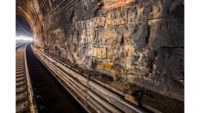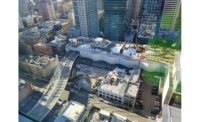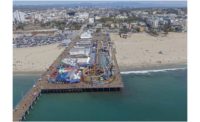Proceeding from the newer main west entrance toward the apse one 25-ft-long bay at a time, workers patched half-in.-wide cracks up to 25 ft long as well as chips, grout and mortar joints. They also repaired decades-old Akoustolith tiles and coatings and cleaned alkali stains, dust and soot from ceiling sections and stained-glass windows. The crew jacked back into position pointed gothic arches at the clerestory level and regrouted them to reestablish compression and load transfer across the arch groins.
Because there is no ledge around the junction of the cathedral's nave and transepts, the contractor hoisted a modular suspended access system, typically used for the underside of bridges and other high structures. Four 1¼-in. wire-rope cables were strung through existing holes in the vaulted ceiling and connected to a scaffolding system in the cathedral's attic.
Though most of the interior repairs proved to be more a curiosity than a concern to cathedral staff and visitors, the work schedule was rarely routine.
"There were 15 pages of contract specifications devoted solely to events," says Davis Project Manager Brent Burger, adding that, while no events had to be cancelled because of the repairs, "each week brought new coordination issues."
Although most of the cathedral's 44 flying buttresses experienced minor damage, the earthquake exacerbated decades of ground settlement beneath six 114-ft, 4-in.-tall piers and 14-ft-long flyers that support the apse, resulting in cracked and spalled arch stones. To prevent future loss of compression in each flyer, an angled 3-in.-dia core was drilled to 30-ft depths between the pier and the building. Liquid levels and tilt meters at 10 locations on each buttress helped monitor stability during the drilling process. The crew inserted a 11/8-in.-dia threaded stainless-steel rod and filled the hole with a special grout mixture.
"We tested 22 varieties of grout over eight months before finding the ideal 5,000-psi recipe that matched the stone's stiffness under all conditions," Burger says, adding that the pumped grout often migrated into a labyrinth of masonry voids within the apse. "We had no idea where it went, except for a few times when it leaked out on the inside, which we then have to clean and patch."
Setting Things Straight
Atop the apse buttress piers and clerestory level, pinnacles ranging from 17 to 20 ft tall were vertically stabilized, as well. Approximately 35 exterior pinnacle stones were removed, repaired, strengthened and replaced using 120- and 155-ton cranes; to prevent future rotation, 7/8-in. rods were inserted up to 17 ft, 4 in., deep into center-cored shafts and augmented with anchors in the stone courses. This approach was similar to a strategy that was validated by shake-table earthquake tests at Columbia University's Carleton Laboratory. When funds for the repair program's second phase are secured, the technique will be used to repair a total of 12 grand pinnacles on the central and west towers. Other tasks include stabilizing transept turrets and enhancing the stability of the remaining buttresses along both sides of the nave.
"Seven-eighths of the exterior work still needs to be done," says Jim Shepherd, the cathedral's director of preservation and facilities, adding that "chisel-ready" drawings developed during first-phase repairs will go a long way in planning the next steps.
"We're just hopeful that we can begin at least some of that work soon because things will only become more expensive," Shepherd notes.









